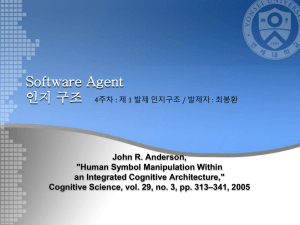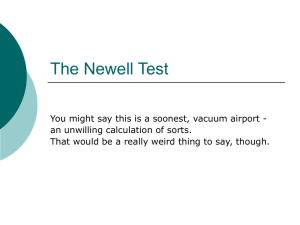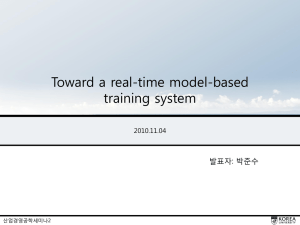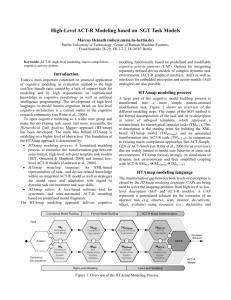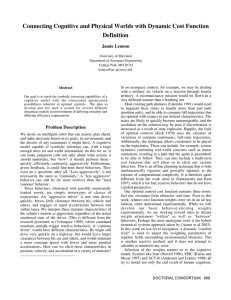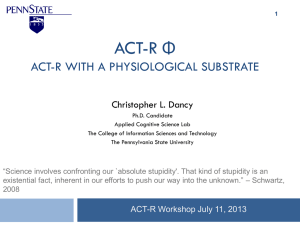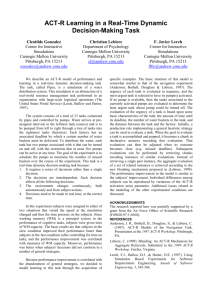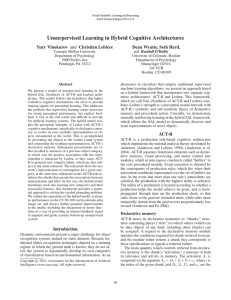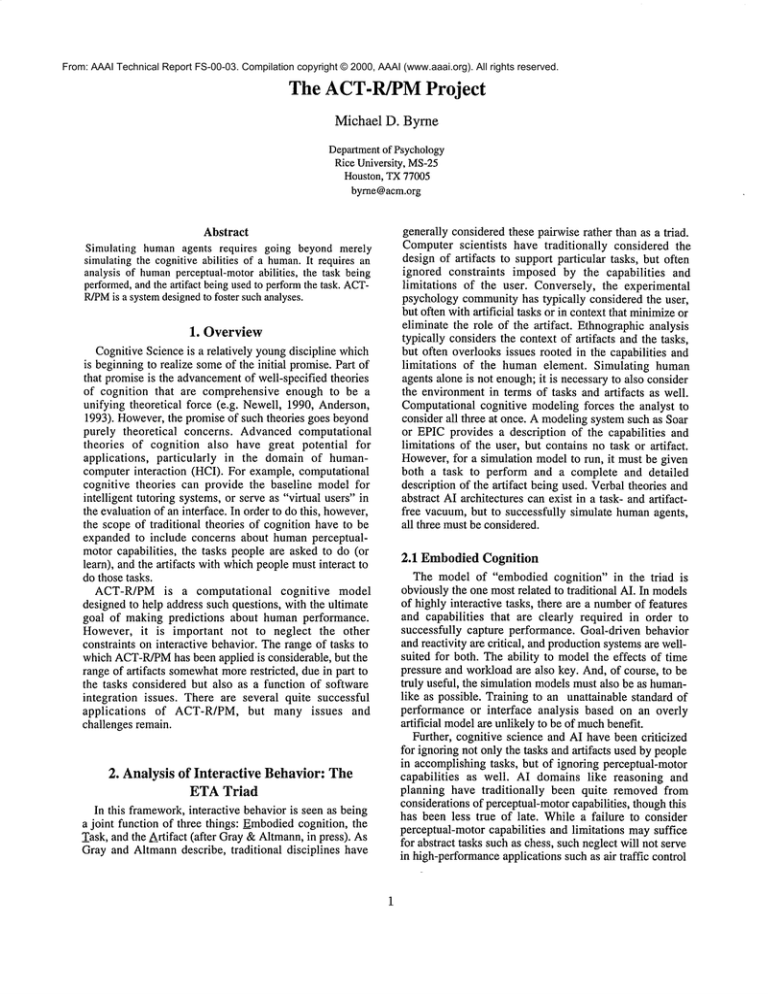
From: AAAI Technical Report FS-00-03. Compilation copyright © 2000, AAAI (www.aaai.org). All rights reserved.
The ACT-R/PMProject
Michael
D. Byrne
Departmentof Psychology
Rice University, MS-25
Houston, TX77005
byrne@acm.org
Abstract
Simulating human agents requires going beyond merely
simulating the cognitive abilities of a human.It requires an
analysis of humanperceptual-motor abilities, the task being
performed,and the artifact being used to performthe task. ACTR/PMis a systemdesignedto foster such analyses.
1.
Overview
Cognitive Science is a relatively young discipline which
is beginning to realize someof the initial promise. Part of
that promise is the advancementof well-specified theories
of cognition that are comprehensive enough to be a
unifying theoretical force (e.g. Newell, 1990, Anderson,
1993). However, the promise of such theories goes beyond
purely theoretical
concerns. Advanced computational
theories of cognition also have great potential
for
applications,
particularly
in the domain of humancomputer interaction (HCI). For example, computational
cognitive theories can provide the baseline model for
intelligent tutoring systems, or serve as "virtual users" in
the evaluation of an interface. In order to do this, however,
the scope of traditional theories of cognition have to be
expanded to include concerns about human perceptualmotor capabilities,
the tasks people are asked to do (or
learn), and the artifacts with which people must interact to
do those tasks.
ACT-R/PM is a computational
cognitive
model
designed to help address such questions, with the ultimate
goal of making predictions about human performance.
However, it is important not to neglect the other
constraints on interactive behavior. The range of tasks to
which ACT-R/PM
has been applied is considerable, but the
range of artifacts somewhatmore restricted, due in part to
the tasks considered but also as a function of software
integration issues. There are several quite successful
applications
of ACT-R/PM, but many issues
and
challenges remain.
2. Analysis
of Interactive
Behavior:
The
ETA Triad
In this framework, interactive behavior is seen as being
a joint function of three things: Embodiedcognition, the
Task, and the Artifact (after Gray & Altmann, in press).
Gray and Altmann describe, traditional disciplines have
generally considered these painvise rather than as a triad.
Computer scientists
have traditionally
considered the
design of artifacts to support particular tasks, but often
ignored constraints
imposed by the capabilities
and
limitations of the user. Conversely, the experimental
psychology community has typically considered the user,
but often with artificial tasks or in context that minimizeor
eliminate the role of the artifact. Ethnographic analysis
typically considers the context of artifacts and the tasks,
but often overlooks issues rooted in the capabilities and
limitations
of the human element. Simulating human
agents alone is not enough; it is necessary to also consider
the environment in terms of tasks and artifacts as well.
Computational cognitive modeling forces the analyst to
consider all three at once. A modeling system such as Soar
or EPIC provides a description of the capabilities
and
limitations of the user, but contains no task or artifact.
However, for a simulation model to run, it must be given
both a task to perform and a complete and detailed
description of the artifact being used. Verbal theories and
abstract AI architectures can exist in a task- and artifactfree vacuum, but to successfully simulate human agents,
all three must be considered.
2.1 Embodied Cognition
The model of "embodied cognition" in the triad is
obviously the one most related to traditional AI. In models
of highly interactive tasks, there are a numberof features
and capabilities
that are clearly required in order to
successfully capture performance. Goal-driven behavior
and reactivity are critical, and production systems are wellsuited for both. The ability to model the effects of time
pressure and workload are also key. And, of course, to be
truly useful, the simulation models must also be as humanlike as possible. Training to an unattainable standard of
performance or interface analysis based on an overly
artificial model are unlikely to be of muchbenefit.
Further, cognitive science and AI have been criticized
for ignoring not only the tasks and artifacts used by people
in accomplishing tasks, but of ignoring perceptual-motor
capabilities
as well. AI domains like reasoning and
planning have traditionally
been quite removed from
considerations of perceptual-motor capabilities, though this
has been less true of late. While a failure to consider
perceptual-motor capabilities and limitations may suffice
for abstract tasks such as chess, such neglect will not serve
in high-performance applications such as air traffic control
and in-car navigation systems. As computer systems
becomeincreasingly embeddedand mobile, the demands
they place on our perceptual-motor systems are likely to
becomeincreasingly central in understanding interactive
behavior. Thus, we needtheories and applications that pay
morethan merelip service to these issues.
2.2 The Task
The next componentto be consideredis the Task. Issues
in determiningthe true task to be analyzedare overlooked
with surprising frequency. For example,recent studies of
WWW
behavior--certainly a "hot" topic-- (e.g. Nielsen,
1997; Tauscher & Greenberg, 1997) have failed to
consider whetherthe tasks they ask users to do are typical
of the tasks users actually use the WWW
to accomplishin
their normal use of the Web.Optimizing interfaces or
training regimensfor tasks for whichthey are not actually
being employedis a waste of time and effort. Methodslike
protocol analysis, contextual inquiry, and ethnographic
analysis can be invaluablein understandingthe actual tasks
in which users are engaged. A thorough analysis of the
goal structure/decomposition, such as GOMS,
entailed by
the actual task plays a critical role in informingthe modelbuilding process.
A secondimportant issue is the wayby whichsuccess in
performinga task is measured.Is it time, user satisfaction,
or someother metric? In high-performancesystems, time
and errors are likely to be the mostcentral measureswith
things like user preference and satisfaction less critical
(thoughstill not completelyunimportant).
PerceptualMotorLayer
Figure 1. ACT-R/PM
System
2.3 The Artifact
In general, the HCIcommunityhas been muchbetter at
understanding and augmentingthe Artifact. The artifact
determines which operators the user can apply to reach
their goals and often plays a central role in maintaining
state informationfor the task. Theartifact is the component
that is most subject to design--it is often mucheasier to
redesign the device than change the underlying task or
changethe cognitive, perceptual, or motorcharacteristics
of the user, thoughthere are exceptions. For example,it
can be nearly impossibleto modifya physical artifact for a
space missionduringflight.
The design of the artifact is typically fraught with
tradeoffs, such as the tradeoff betweenthe goal of making
informationavailable to the user and limitations of screen
space. In fact, one of the central potential uses of
performanceanalysis such as computationalmodelingis to
help evaluatesuch tradeoffs.
Oneof the importantpieces of this framework
is fidelity
to true artifacts. In computingsystems,the artifact in the
analysis is moreoften than not a piece of software. In that
spirit, one goal of researchers in computationalmodeling
and HCIis the use of the samesoftware both by users and
by the computational cognitive models. This can require
solving non-trivial softwareintegration problems.
2
3. The ACT-R/PM Project
ACT-R/PM
is a computational cognitive architecture
based on ACT-R (Anderson & Lebiere, 1998),
activation-based production system with manyneuralnetwork-like properties. Whileproduction systems are not
particularly popular amongcurrent AI researchers, the
ACT-Rhybrid approach has been quite successful at
modeling manyaspects of humancognition (Anderson
Lebiere, 1988), and thus seems appropriate for building
human-likeagents.
The ACT-Rproduction system forms the "cognitive
layer" of the system. Interaction between the cognitive
systemand a device(simulatedor "real" in the sense that it
is the samesoftware used by humansubjects) is mediated
by the perceptual-motor layer. The perceptual-motor
system contains an attention-based visual system, an
attention based auditory system, and motor and speech
systems based on those found in EPIC (Kieras &Meyer,
1996). Thesemodulesare not all necessarily detailed or
complete models of humancapabilities and limitations;
manydetails are abstracted out. However,they are all
based on empirical humanperformance data, which again
is deemedcritical to the success of constructing humanlike agents. These modulesare actively being refined as
the approximations break down, though the refinement
process is decidedlyconservative.
ACT-R/PMcan form the basis of the theory of
"embodiedcognition" in the ETAtriad given its roots in
the humanperformanceliterature. However,this literature
is not as completein manyrespects as one wouldwant it to
be. Psychologistshave not alwaysasked the right kinds of
questions to address issues involved in simulating human
agents. ACT-R/PM
represents a selective synthesis of the
current literature along with numerous guesses and
approximations that have up to this point served well.
However,as the breadth of application widens, further
limitations in our knowledgeabout the humancognitive-
perceptual-motor system will undoubtedlysurface. These
provide both opportunity and challenge. The opportunity
lies in the empiricalworkthese limitations will inspire; the
challenges are what to do in terms of systemdesign while
these questions are being answered.
The range of tasks to which ACT-R/PMhas been
applied is substantial, from very simple laboratory
experimentson dual-task interference (Byrne& Anderson,
1998) to complex command-and-control like tasks
(Schoelles &Gray, 2000; Lee, 2000). Taking on a broad
range of tasks provides evidence for the soundnessof the
underlying theory; it is possible to model large and
complextasks without having to sacrifice veridicality in
the details for smaller tasks in more tightly-controlled
situations.
Typical GUIsare the primary domainof artifacts to
which ACT-R/PM
has been applied. This is an excellent
starting domainfor several reasons. First, it is relatively
straightforward to workwith this domain.Issues with 3D
vision can mostly not be addressed, and the set of actions
available to the agent is limited, which constrains the
motor domainas well. Second, there is no shortage of
interest in this domain,both theoretically and practically.
The domain is both rich enough to be interesting and
simple enoughto be tractable.
ACT-R/PM
"understands" simple GUIwidgets (labels,
buttons) implemented in the Macintosh Common
Lisp
environment (MCL), and extension to more complex
visual environments and dialogs is relatively
straightforward. Workis underwayat Carnegie Mellonto
integrate this functionality with Allegro Common
Lisp for
the Windowsplatform, which would also be a win. In
principle, it should be possible to link ACT-R/PM
to
nearly any softwareinterface; in practice this can actually
be quite difficult, particularly when access to the
underlying code driving the interface cannot be modified.
Recent workon this kind of integration problemhas been
doneelsewhere(e.g. Ritter, et al., in press; St. Amant,et
al., in press), but ACT-R/PM
lags somewhatbehind these
efforts.
In fact, there are a great manychallenges that remain.
There are places where the integration of the cognitive
layer and the perceptual-motorlayer is not entirely smooth,
and manyunansweredquestions about howto managethat
integration. Manyof these questions revolve around
vision: cognitive control of attention vs. exogenous
control, representation of the visual scene in a language
that is sensible for a production system, makingthose
memories consistent with ACT-R’s activation-based
system, enforcing visual guidance constraints on aimed
movements,and so on.
Furthermore, building a large ACT-R/PM
model for a
task like air traffic control is not a trivial undertakingby
any means. There has been some, though clearly not
enough, modularization of the modelsconstructed in ACTR/PMsuch that pieces of one simulation can easily be
adapted for use in another. The people constructing such
models are academic researchers,
typically ACT-R
specialists, whohand-code knowledgewith diligence and
patience.
Finally, ACT-R/PM
is not unlimited in scope. ACTR//PMhas little to say about numerousthings that clearly
impact humanperformance on task to which agents are
applied, such as fatigue. ACT-R/PM
can be used to model
execution time, learning, and error rates in human
performance, but has little to say about personal
preferences or user satisfaction (though one might be
inclined to presumethat in the long run, users will prefer
interfaces whichallow themto achieve their goals with a
minimum
of time and effort).
Despite these limitations, ACT-R/PM
as a project has so
far beenquite successful. As mentioned,the range of tasks
to whichit has beenappliedis substantial, andthis rangeis
being expandedby researchers at multiple institutions.
Admittedly, most of the projects for which ACT-R/PM
has
been utilized are more along the lines of basic
psychologicalresearch than direct application or advances
in AI technology, but certainly the project is relevant to
both of these concerns. One of the advantages of working
in the context of ACT-R
is that there is an active research
community working on a variety of issues and the
underlying cognitive theory is revised to maximizethe
breadthand veridicality of the theory.
4. References
Anderson, J. R. and C. Lebi6re, Eds. (1998). Atomic
componentsof thought. Hillsdale, NJ, Erlbaum.
Byrue, M. D., &Anderson, J. R. (1998). Perception and
Action. In J. R. Anderson& C. Lebiere (Eds.) The
Atomic Components of Thought (pp. 167-200).
Mahwah,NJ: Lawrence Erlbaum.
Lee, F. J. (2000). Doeslearning of a complextask have
be complex?A study in learning decomposition. Ph.D.
Thesis, CarnegieMellonUniversity. Pittsburgh, PA.
Nielsen, J. (1997). How Users Read on the Web.
http://www.useit.com/alertbox/9710a.html
Newell, A. (1990). Unified theories of cognition.
Cambridge,MA,Harvard University Press.
Ritter, F. E., Baxter, G. D., Jones, G., &Young,R. M. (in
press). Supporting cognitive models as users. ACM
Transactions on Computer-Human
Interaction.
Schoelles, M. J., &Gray, W. D. (2000). Argus Prime:
Modeling emergent microstrategies in a complex,
simulated task environment. Paper presented at the
2000International Conferenceon Cognitive Modeling.
St. Amant, R., Riedl, M. O., & Zettlemoyer, L. S. (in
press). A practical perception substrate for cognitive
modeling in HCI. International Journal of HumanComputerStudies.
Tauscher,L., &Greenberg,S. (1997). Revisitation patterns
in World Wide Webnavigation. In HumanFactors in
Computing Systems: Proceedings of CHI 97
(pp.399-406). NewYork: ACMPress.

